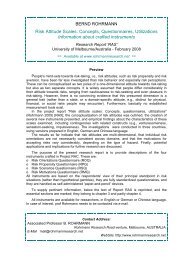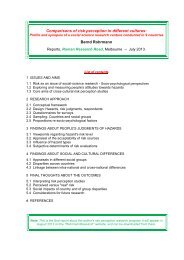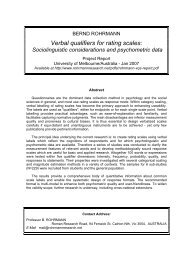Risk Attitude Scales: Concepts, Questionnaires, Utilizations
Risk Attitude Scales: Concepts, Questionnaires, Utilizations
Risk Attitude Scales: Concepts, Questionnaires, Utilizations
You also want an ePaper? Increase the reach of your titles
YUMPU automatically turns print PDFs into web optimized ePapers that Google loves.
ROHRMANN - <strong>Risk</strong> <strong>Attitude</strong> <strong>Scales</strong> 17<br />
Relationship of risk attitudes to other constructs (Data: Studies RAM, RAS)<br />
<strong>Risk</strong> attitude variable other constructs correlation rij<br />
ROQ-Propensity SSS Sensation-seeking ~ 50<br />
ROQ-Cautiousness SSS Sensation-seeking ~ -50<br />
ROQ-Propensity EIQ Impulsiveness ~ 40<br />
ROQ-Cautiousness EIQ Impulsiveness ~ -60<br />
ROQ-Propensity HEQ <strong>Risk</strong> acceptance ~ 10<br />
ROQ-Cautiousness HEQ <strong>Risk</strong> acceptance ~ -30<br />
4.5 Project outcomes so far<br />
In sum, it appears that the presumed risk attitude is not a 1-dimensional generic<br />
personality feature. How strong a person's risk propensity or risk aversion 'comes to life'<br />
depends on the type of hazard to be dealt with, such as physical risks, financial risks, and<br />
social risks; different mind-sets and motivations for accepting risks are relevant in these<br />
contexts. People's risk attitudes are likely to be influenced by other personality<br />
characteristics, such as sensation-seeking or impulsivity, but they are not just a derivate of<br />
such factors.<br />
However, how exactly risk propensity/aversion affect risk acceptance and actual risk<br />
behavior is yet to be clarified.<br />
5 Needs and plans for future research<br />
5.1 Significance of risk attitude studies<br />
Research into the conceptualization, measurement and effects of risk attitudes can<br />
provide several benefits:<br />
o For fundamental (theory-centered) research, clarifying discrepant findings about the<br />
validity of risk attitudes are to be gained;<br />
o for methodological research, appropriate instruments which reflect the complexity of<br />
people's thinking about risk situations can be provided;<br />
o For applied (problem-centered) research, understanding risk mind-sets is essential for<br />
designing hazard information and risk communication programs (in occupational or<br />
private contexts).<br />
5.2 Necessity of further research<br />
It is obvious that many facets of risk attitudes are not yet sufficiently clarified; this applies<br />
to both to the roots and the impacts of risk propensity/aversion. Main research needs include:<br />
Wider sampling (including actual risk-takers), systematic reliability analyses for instruments;





